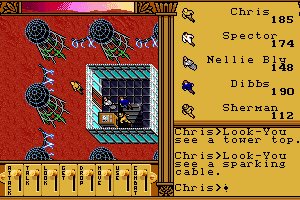

- Ultima worlds of adventure 2 martian dreams software#
- Ultima worlds of adventure 2 martian dreams plus#
- Ultima worlds of adventure 2 martian dreams series#
Later, after spending some two years making Ultima IV all by himself, Garriott himself had floated the idea of an Ultima IV Part 2 to squeeze a little more mileage out of the engine, only to abandon it to the excitement of building a new engine of unprecedented sophistication for Ultima V. As far back as Ultima II, in the days before Origin even existed, a rumor had briefly surfaced that Sierra, Garriott’s publisher at the time, might release an expansion disk to connect a few more of the many pointlessly spinning gears in that game’s rather sloppy design. It wasn’t actually an unprecedented idea. What if a separate team used the last Ultima engine to create some “spin-off” games while Garriott and his team were busy inventing their latest wheel for the next “numbered” game in the series?

Origin’s recently arrived producer and designer Warren Spector was as practical as he was creative, and thus could relate to the concerns of both a Dallas Snell and a Richard Garriott. Others, most notably the original promise-maker himself, were none too happy with the idea. If they wished to survive, Origin too had to stop throwing away their technology after only using it once they had to renege at last on Richard Garriott’s longstanding promise. The more practical voices at the company, such as the hard-nosed head of product development Dallas Snell, said that Origin simply had to start following the example of their rivals, who reused their engines many times as a matter of course. These were very good numbers for the genre and the times, but it seemed that Origin had long ago hit a sales ceiling for games of this type.
Ultima worlds of adventure 2 martian dreams series#
Each new entry in the series since Ultima IV had continued to sell a consistent 200,000 to 250,000 copies.
Ultima worlds of adventure 2 martian dreams software#
Making a new Ultima from the ground up had by this point come to entail much more than just writing a game engine it required a whole new technical infrastructure of editors and other software tools that let the design team, to paraphrase Origin’s favorite marketing tagline, create their latest world.īut, while development costs thus skyrocketed, sales weren’t increasing to match.
Ultima worlds of adventure 2 martian dreams plus#
It was quite another thing in the case of a game like 1990’s Ultima VI, the first Ultima to be developed for MS-DOS machines with VGA graphics and hard drives, a project involving four programmers and five artists, plus a bureaucracy of others that included everything from producers to play-testers. To build each new entry in the series from the ground up was one thing when doing so entailed Garriott disappearing alone into a small room containing only his Apple II for six months or a year, then emerging, blurry-eyed and exhausted, with floppy disks in hand. Yes, games like The Bard’s Tale and Pool of Radiance racked up some very impressive sales of their own as the 1980s wore on, but Ultima… well, Ultima was simply Ultima, the most respected name of all in CRPGs.Īnd yet by 1990 the promise which had served Richard Garriott so well was starting to become a real problem for his company Origin Systems. While the first five Wizardry installments remained largely indistinguishable from one another to the casual fan, Ultima made major, obvious leaps with each new release. When the first Ultima had appeared in 1981, it had lagged well behind the first Wizardry in terms of sales and respect, but by the time Ultima III dropped in 1983 Garriott’s series had snatched a lead which it would never come close to relinquishing. For quite some time, this policy served Garriott very well indeed. Before every new installment of his series, he would tear everything down to its component parts and rebuild it all, bigger and better than ever before. Looking for a way to differentiate his CRPG series from its arch-rival, Wizardry, he said that he would never reuse an Ultima engine. In the very early days of Ultima, Richard Garriott made a public promise which would eventually come back to haunt him.

Proud papa Warren Spector with a copy of Worlds of Ultima II: Martian Dreams.


 0 kommentar(er)
0 kommentar(er)
